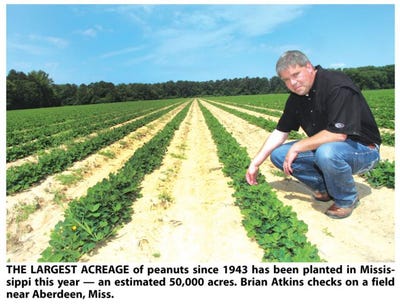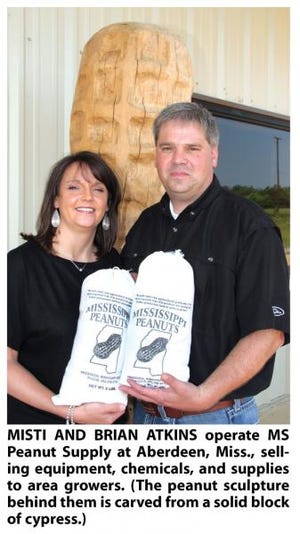
Mississippi led the nation in peanut yields in 2011, with an average 4,200 pounds per acre. Production is centered mostly in the Delta counties to the west and in the eastern counties along the Tombigbee River. “Sandy soils and water, an ideal combination for peanuts, make these areas attractive for us,” says Brian Atkins, manager of the Prairie, Miss., buying point for Birdsong Peanuts, a world leader the peanut industry.

On a portion of the east Mississippi prairie land that was the site during World War II of a sprawling munitions production complex where 6,000 to 10,000 women packed shells for the U.S. military effort, a giant peanut buying/grading/shipping facility is racing to complete a $3 million expansion of its $10 million plant that expects to handle 24,000 to 30,000 tons of the state’s largest peanut crop since 1943.
The USDA is estimating a 233 percent increase in Mississippi peanut plantings this year, for a total of about 50,000 acres.
This on the heels of the severe drought last year in the major Texas production areas that sent prices skyrocketing to as much as $1,000 per ton at harvest and created widespread producer interest in locations suited to growing the crop.
Mississippi led the nation in peanut yields in 2011, with an average 4,200 pounds per acre. Production is centered mostly in the Delta counties to the west and in the eastern counties along the Tombigbee River.
“Sandy soils and water, an ideal combination for peanuts, make these areas attractive for us,” says Brian Atkins, manager of the Prairie, Miss., buying point for Birdsong Peanuts, a world leader the peanut industry.
The family-owned company, with corporate headquarters at Suffolk, Va., started in the peanut business in 1914 and now has about 35 percent of the U.S. market, with buying points from Virginia to Texas.
Birdsong has 80 buying points and seven shelling plants in the U.S. One of its major customers is Smucker’s, which uses 1 million pounds of peanuts a day and makes Jif, the most popular brand of peanut butter. The peanut butter in Butterfinger candy bars is 100 percent from Birdsong peanuts, Atkins says.
The company is also nearing completion of a new state of the art mega-buying point at Walnut Ridge, Ark., that will be the same size as the Prairie facility. About 25 growers have planted about 9,000 acres for Birdsong in that area, and about 45 Mississippi growers have planted 15,000 to 22,000 acres for the company.
“We’ve got growers from Tylertown to Tunica on the west side of the state and from Tishomingo County to Forrest County on the east side,” says Atkins. “Our territory for this buying point also includes parts of Louisiana, and north Alabama.”
The company is currently evaluating locations for a buying point in the Mississippi Delta, he says, possibly in the Coahoma/Tunica County area.
“A lot of growers have booked peanuts this year in the $750 per ton range,” Atkins says. “At present, no contracts are being offered as growers and buyers wait to see how the season will go.
“Some peanuts were planted as early as April 5 in the Tunica area, and the crops are looking good everywhere. If we can get some timely rains and no weather setbacks at harvest, it should be another good year.
A weather/demand market
“From now on, it will be a weather/demand market,” he says. “A really large crop could bring prices down, but an average to below-average crop could keep them high. Not a lot of growers had uncommitted peanuts last year to take advantage of the $1,000 price, but many had contracted at $550 and up.”
With the bumper 2011 crop, “Our two 90,000 square foot warehouses were both full,” Atkins says.” We took in 843 18-wheeler loads, or about 18,000 tons. Average yield was about 4,000 pounds for dryland peanuts and 5,000 pounds for irrigated. Most of the peanuts here on the east side of the state are dryland, but peanuts don’t need as much water as other crops and with timely rains can produce well.
“It takes a pretty good investment to make a peanut crop, and a high level of management. But efficient, well-organized farmers can make good money with the crop.
“There was a tremendous amount of enthusiasm for peanuts this year. At a meeting for prospective growers at Clarksdale, Miss., we had more than 130 people attend. We could have signed a lot more growers, but we had to quit because we didn’t want to exceed the level where we knew we could handle everything efficiently and give our growers the best service possible.
“If this is a successful year, I think we’ll see even more acreage in coming seasons. Once growers learn about our operation and the investments we’ve made in the future of the industry here, they understand that we’re going to be with them for the long haul. We’ll be growing our infrastructure in keeping with acreage increases.
“With our buying point locations at Prairie and Walnut Ridge, we can now ship peanuts east or west.”
With the early planting this year, he says, peanuts are expected to start coming in somewhere around Labor Day, about a month earlier than normal.
“We’ll get the bulk of our peanuts during September and October, and hope to be finished by Thanksgiving, but sometimes we’ll go into early December.
“We pay the freight to haul our growers’ peanuts here, and we provide the 18-wheel trailers to insure that there is no contamination from other crops or products. The Prairie facility has three dryer sheds and can dry 78 trailer loads per night. The peanuts come in green, at 18 percent moisture or below. Some have to be cleaned first; then they’re dried down and graded. If they’re above 12 percent, they are dried down to 10.5 percent before going into the USDA-inspected warehouses.
“We hold them there until they’re shipped to our shelling plant. Some have to be cleaned first; then they’re dried down and graded, after which they’re placed in the warehouse until we send them to the shelling plant. We can hold them in the warehouse for up to nine months, but they’re a perishable item and we handle them as quickly as possible. This year, we’ll be sending them to the Brownfield, Texas, shelling plant because capacity is available there as a result of last year’s short crop.
“My ultimate goal is to get a shelling plant here in Mississippi, which will take about 100,000 tons of production to justify the $25 million investment.”
All of Birdsong’s Mid-South growers plant the Georgia 06 variety, which performs well in this region, Atkins says. “It’s the main market variety for peanut butter and candy. Peanut butter is the driving force in the peanut market.
$10 million paid to growers
“Last year, we paid out $10 million from this shipping point to our peanut growers. That’s money that goes into local communities and circulates several times over. “Additionally, we use mostly local contractors and local labor for all our construction work, plus local truck drivers for hauling. We have five full-time workers here at the plant and 30 seasonal workers.”
One advantage of growing peanuts in new areas, such as in the Mid-South, is a reduced disease incidence, Atkins says. “Growers here have to spray fungicides for disease control only three or four times per season, compared to seven or eight in Georgia. That’s a substantial cost savings.
“White mold is our main disease threat. But our agronomist/consultants, Alan Blaine and Mitt Wardlaw, work with growers on production issues and problems such as diseases. They’re very good about advising growers to spray only when necessary. Every application you don’t have to make is just that much more toward the bottom line.
“Also, we stress to our growers the importance of rotation in order to help keep down diseases. We recommend a three-to-one rotation with corn or cotton.
“Our soils here are high in calcium, and we don’t have to apply gypsum the way they do in Georgia or other traditional production areas, which is another cost savings.”
Until recent years, the Mid-South has been only a minor player in peanut production. Under the government quota program that was in effect for decades, the bulk of U.S. peanut acreage was in Georgia and the Carolinas.
“There wasn’t enough acreage here to justify the expense of a support infrastructure,” Atkins says. “When quotas were eliminated in the 2002 farm bill, anyone could grow peanuts.
“Birdsong was the first company to come in and work with Mississippi farmers who were interested in growing the crop. They invested $8 million in this facility in 2005 and have expanded the operation as acreage has increased.
“It was something of a gamble, with peanuts at only $400 a ton at the time, and growers who were completely new to the crop. But the long term outlook here was good, particularly in view of declining water supplies in the Texas panhandle and disease problems and urban sprawl in the Carolinas and Virginia.
“Mississippi has more peanut acres this year than Virginia, a long-time major production area, which has been hurt by diseases and urban sprawl.”
Atkins himself says peanuts played a role in a career change for him and a cropping change on their family’s farming operation.
“I was raised on our farm, where we grew mostly cotton. When the bottom fell out of the cotton market, we knew we couldn’t survive on loan rate cotton and looked for an alternative. We started growing peanuts and have done well with them — they’ve helped keep the farm in business.”
After earning his degree in agricultural engineering technology and business at Mississippi State University, Atkins was Extension agent in Lowndes County, Miss., for 12 years before joining the Birdsong operation.
He and his wife, Misti, also have a store, MS Peanut Supply Co., at nearby Aberdeen, which sells diggers, combines, chemicals, and anything related to production.
“We buy in bulk and pass the savings on to our growers,” he says, “plus they don’t have to do long distances to get what they need.”
This year will be important to the future of peanuts in the Mid-South, Atkins says. “If growers have a good year and feel good about their peanut experience, they’ll increase acres in the years ahead.”
About the Author(s)
You May Also Like



